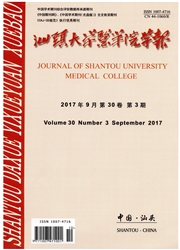

 中文摘要:
中文摘要:
目的 研究快眼动睡眠剥夺(REMSD)抗抑郁机制中腺苷及其受体对抑郁模型大鼠自发活动的影响.方法 成年雄性SD大鼠56只,随机分为正常对照组(8只)和应激模型组(48只),应激模型组经21d慢性不可预见性应激(CUS)和单笼孤养建立抑郁模型,再随机分为抑郁模型组、睡眠剥夺组、水环境对照组、生理盐水对照组、腺苷A1受体拮抗剂组、腺苷A2A受体拮抗剂组,每组各8只;行72h REMSD观察大鼠自发活动路程的变化.结果 72h REMSD后,睡眠剥夺组总路程、中央路程、周边路程大于水环境对照组,差异有统计学意义(P<0.05);72h REMSD后,腺苷A1受体拮抗剂组总路程和周边路程较前明显增加,差异有统计学意义(P<0.01),中央路程无明显变化,差异无统计学意义(P>0.05);72 h REMSD后,腺苷A2A受体拮抗剂组总路程和周边路程较前显著增加,差异有统计学意义(P<0.01),中央路程增加,差异有统计学意义(P<0.05).结论 72h REMSD可使抑郁模型大鼠的自发活动增加,在72h REMSD过程中腺苷A1受体或A2A受体失活时也可使抑郁模型大鼠的自发活动增加.
 英文摘要:
英文摘要:
Objective To investigate the effects of adenosine and its receptors for spontaneous activities of depression-model rats in anti- depressive mechanism of Rapid-Eye-Movement sleep deprivation ( REMSD ) . Methods 56 adult males Sprague-Dawley rats were randomly divided into two groups: normal control group ( n=8 ) and stress-model group ( n=48 ) . The stress-model group used chronic unpredicted stress ( CUS ) and Single cage solitary raise way to establish depression model. The stress-model group were divided into six groups in randomized method: the depression-model group ( n=8 ) , sleep deprivation group ( n=8 ) , water control group ( n=8 ) , adenosine A1 receptor antagonist group ( n=8 ) , adenosine A2A receptor antagonist group ( n=8 ) , saline group ( n=8 ) . The function of the 72h REMSD was to observe the changes of rats spontaneous activities of the distance. Results After 72 hours sleep deprivation, the total distance the central distance and the around distance in sleep deprivation group was longer than that in water control group ( P〈0.05 ) ; After 72h REMSD, the total distance and the around distance in A1 receptor antagonist group increased significantly compared with that before perform ( P〈0.01 ) , the central distance had no significant difference ( P〉0.05 ) . After 72 h REMSD, the total distance and the around distance in A2A receptor antagonist group increased significantly compared with that before perform ( P〈0.01 ) , the central distance increased compared with that before perform ( P〈0.05 ) .Conclusion The spontaneous activities of depression-model rats can be increased by 72h REMSD. In the process of 72h REMSD, the spontaneous activities of depression-model rats can be also increased when the A1 receptor antagonist or A2A receptor antagonist were inactivated.
 同期刊论文项目
同期刊论文项目
 同项目期刊论文
同项目期刊论文
 期刊信息
期刊信息
